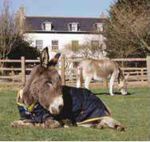Clinical Examination (Geriatric) - Donkey
General considerations

Routine clinical examination of the geriatric donkey should naturally include assessment of all the ten body systems but it is useful to take time to stand back and take a more holistic view of the animal and the conditions under which it is kept. Allow time to monitor general demeanour prior to any hands-on examination.
It is wise to remember that donkeys are capable of forming extremely strong bonds with companions and can easily be stressed by being parted from them even for the short period of time needed to perform a clinical examination. This is even more important in the older animals where geriatric companions may have a lifelong commitment to one another. Keep such animals close by throughout the assessment.
Consider offering a small quantity of palatable, succulent feed and observe prehension/feeding behaviour. Beware sham feeding where the donkey seems to be interested and eating but in reality is often only ‘playing’ with the contents of the bucket or trough. This is a good time to monitor for quidding. Also animals that have been fed in a group will often appear to have ‘eaten-up’ perfectly well when they have actually been increasingly anorexic for some time.
A blood sample should be taken early in the examination and allowed to settle/clot. Secondary hyperlipaemia is a common and serious complicating factor in many instances of malaise in both the obese and lean individual. Biochemistry/haematology screening will determine the triglyceride status of the animal (The Donkey Sanctuary offer this service free to clinicians within the UK, see Appendix 10).
When assessed regularly the condition score of the donkey is a useful pointer, not only to how the elderly animal is utilizing feed, but it can also indicate possible low-grade chronic pain from conditions such as osteoarthritis. Many of the common conditions encountered in the ageing donkey can be considered as potential causes of weight loss or ‘ill-thrift’. Hands-on condition scoring is essential; many donkeys have bulky or thick coats which can be deceptive to the eye alone. The clinician must also be aware of the localized subcutaneous fat deposits, e.g. paralumbar, rump, dorsal thoracic ribs and especially at the crest. These may be of a significant size and will often remain even though the donkey has lost a significant amount of body condition. These deposits have a tendency to calcify over time and, in the aged donkey, may easily be mistaken for tumours.
Literature Search
Use these links to find recent scientific publications via CAB Abstracts (log in required unless accessing from a subscribing organisation).
Clinical Examination horses and donkeys related publications
References
- Sprayson, T. (2008) The care of the geriatric donkey In Svendsen, E.D., Duncan, J. and Hadrill, D. (2008) The Professional Handbook of the Donkey, 4th edition, Whittet Books, Chapter 13
|
|
This section was sponsored and content provided by THE DONKEY SANCTUARY |
|---|
